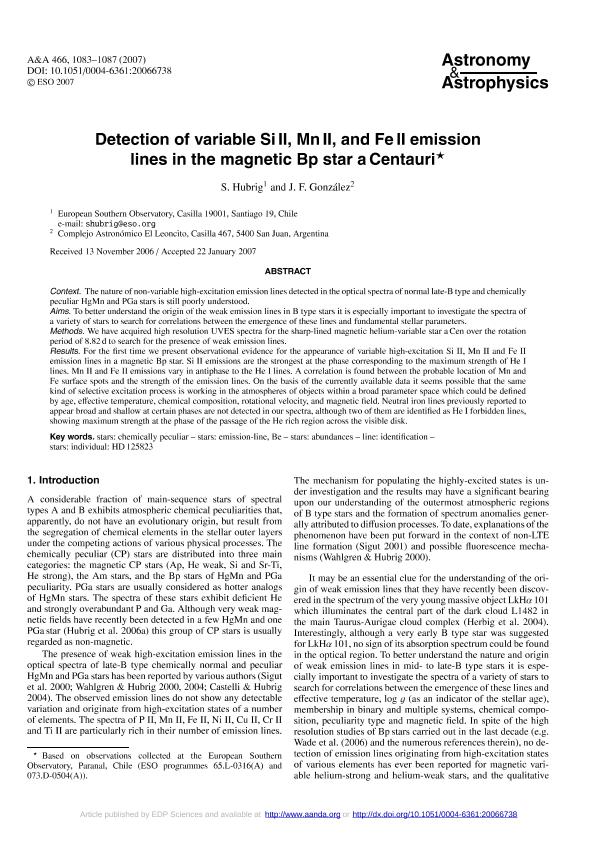Mostrar el registro sencillo del ítem
dc.contributor.author
Hubrig, S.
dc.contributor.author
Gonzalez, Jorge Federico

dc.date.available
2023-10-03T01:43:00Z
dc.date.issued
2007-12
dc.identifier.citation
Hubrig, S.; Gonzalez, Jorge Federico; Detection of variable Si II, Mn II, and Fe II emission lines in the magnetic Bp star a Centauri; EDP Sciences; Astronomy and Astrophysics; 466; 3; 12-2007; 1083-1087
dc.identifier.issn
0004-6361
dc.identifier.uri
http://hdl.handle.net/11336/213844
dc.description.abstract
Context. The nature of non-variable high-excitation emission lines detected in the optical spectra of normal late-B type and chemically peculiar HgMn and PGa stars is still poorly understood. Aims. To better understand the origin of the weak emission lines in B type stars it is especially important to investigate the spectra of a variety of stars to search for correlations between the emergence of these lines and fundamental stellar parameters. Methods. We have acquired high resolution UVES spectra for the sharp-lined magnetic helium-variable star a Cen over the rotation period of 8.82 d to search for the presence of weak emission lines. Results. For the first time we present observational evidence for the appearance of variable high-excitation Si II, Mn II and Fe II emission lines in a magnetic Bp star. Si II emissions are the strongest at the phase corresponding to the maximum strength of He I lines. Mn II and Fe II emissions vary in antiphase to the He I lines. A correlation is found between the probable location of Mn and Fe surface spots and the strength of the emission lines. On the basis of the currently available data it seems possible that the same kind of selective excitation process is working in the atmospheres of objects within a broad parameter space which could be defined by age, effective temperature, chemical composition, rotational velocity, and magnetic field. Neutral iron lines previously reported to appear broad and shallow at certain phases are not detected in our spectra, although two of them are identified as He I forbidden lines, snowing maximum strength at the phase of the passage of the He rich region across the visible disk.
dc.format
application/pdf
dc.language.iso
eng
dc.publisher
EDP Sciences

dc.rights
info:eu-repo/semantics/openAccess
dc.rights.uri
https://creativecommons.org/licenses/by-nc-sa/2.5/ar/
dc.subject
LINE: IDENTIFICATION
dc.subject
STARS: ABUNDANCES
dc.subject
STARS: CHEMICALLY PECULIAR
dc.subject
STARS: EMISSION-LINE, BE
dc.subject
STARS: INDIVIDUAL: HD 125823
dc.subject.classification
Astronomía

dc.subject.classification
Ciencias Físicas

dc.subject.classification
CIENCIAS NATURALES Y EXACTAS

dc.title
Detection of variable Si II, Mn II, and Fe II emission lines in the magnetic Bp star a Centauri
dc.type
info:eu-repo/semantics/article
dc.type
info:ar-repo/semantics/artículo
dc.type
info:eu-repo/semantics/publishedVersion
dc.date.updated
2023-07-07T20:33:27Z
dc.journal.volume
466
dc.journal.number
3
dc.journal.pagination
1083-1087
dc.journal.pais
Francia

dc.journal.ciudad
Paris
dc.description.fil
Fil: Hubrig, S.. European Southern Observatory Santiago; Chile
dc.description.fil
Fil: Gonzalez, Jorge Federico. Consejo Nacional de Investigaciones Científicas y Técnicas. Centro Científico Tecnológico Conicet - San Juan. Complejo Astronómico "El Leoncito". Universidad Nacional de Córdoba. Complejo Astronómico "El Leoncito". Universidad Nacional de la Plata. Complejo Astronómico "El Leoncito". Universidad Nacional de San Juan. Complejo Astronómico "El Leoncito"; Argentina
dc.journal.title
Astronomy and Astrophysics

dc.relation.alternativeid
info:eu-repo/semantics/altIdentifier/doi/http://dx.doi.org/10.1051/0004-6361:20066738
dc.relation.alternativeid
info:eu-repo/semantics/altIdentifier/url/https://www.aanda.org/articles/aa/abs/2007/18/aa6738-06/aa6738-06.html
Archivos asociados
